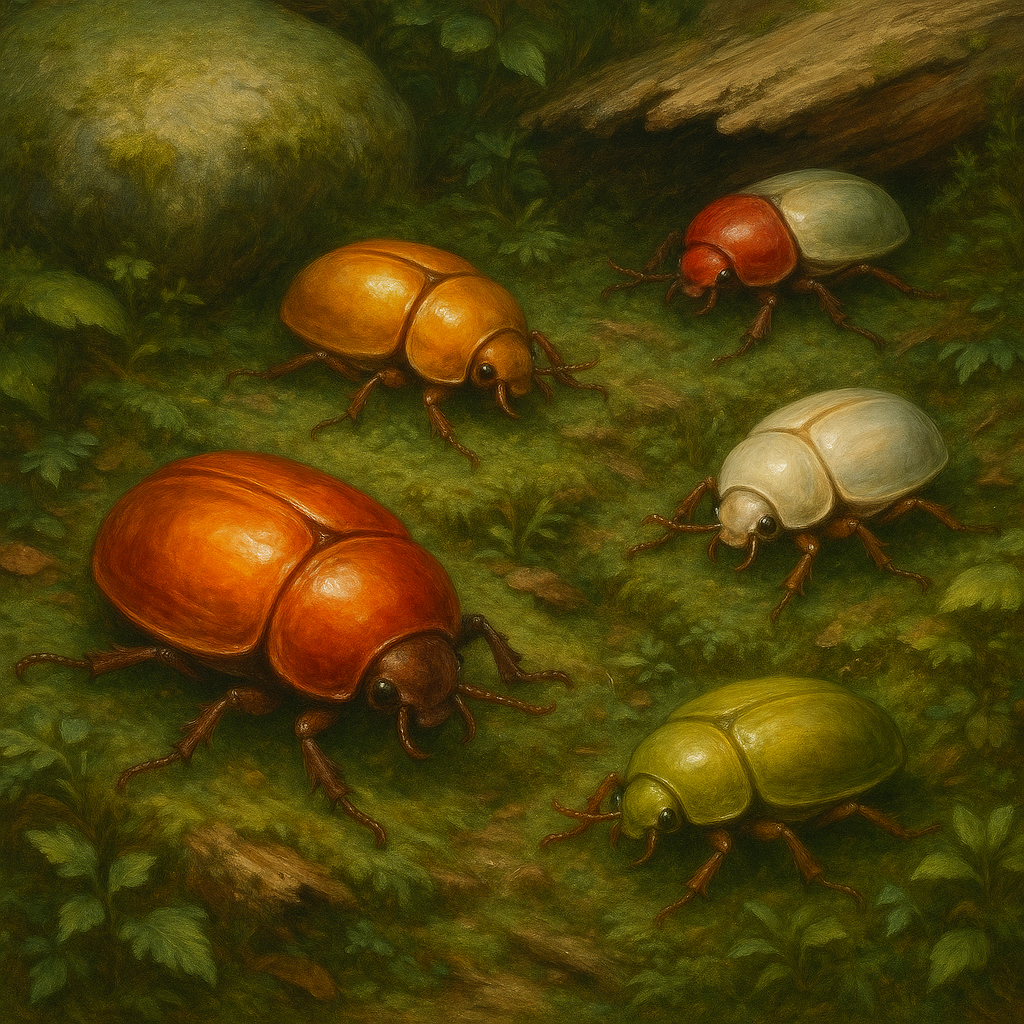Amber Beetles
"Like stones come to life, these beetles do not glitter under the Grandgleam’s light, they burn."
In a forest where nearly everything is dangerous, it is almost a relief that the Amber Beetle is not. Found in abundance beneath the moss-slick stones and rotting logs of The Grandgleam Forest , these slow, armor-plated insects are more curiosity than threat. Their hardened exoskeleton, smooth and translucent like molten resin cooled to perfection, has made them one of the most visually striking creatures in Everwealth. Warm oranges, yellows, and reds dominate their shells, but rare hues of pale green or milky white are said to bring luck to anyone who spots one. Though harmless, they are studied obsessively by naturalists, prized by the Whogi for their shells, and even kept as pets by those with the patience to feed such a stubborn, plodding creature.Basic Information
Anatomy
The Amber Beetle is a medium-sized insect (around the length of a man’s thumb) with a broad, domed carapace that resembles a solid piece of polished amber. Semi-translucent in the right light, its shell allows faint shadows of its interior muscles to be seen moving beneath, giving the impression of something glowing faintly from within. A smaller, sturdily muscled frame sits beneath the plated dome, with strong front pincers designed for levering bark and breaking apart fungi rather than for combat. Their legs are short but powerful, allowing them to cling stubbornly to bark or stone with a strength disproportionate to their size.
Color Variants:
- Common: Amber-orange, golden yellow, rich red.
- Uncommon: Reddish-brown with bright striations or a gradient of two colors.
- Rare: Pale green-yellow ("mossy"), and almost milk-white (“spectral”) Amber Beetles.
Genetics and Reproduction
Amber Beetles follow a simple, stable genetic pattern, with little variation beyond their naturally selected shell pigmentation. These colors are influenced by the minerals in the soil where their larva pupate, meaning regions richer in copper or iron often produce more brilliant shells. Rare colorations (such as green or white) are caused by scarce trace minerals or environmental anomalies.
Growth Rate & Stages
- Larval Stage: Burrowed into damp soil, feeding on fungus and decaying plant matter for several months.
- Pupal Stage: The insect forms a resinous cocoon-like casing, blending perfectly with forest detritus.
- Adult: Emerges with a hardened carapace, fully formed pincers, and a single-minded drive to scavenge and reproduce.
Ecology and Habitats
Amber Beetles are most abundant in the Grandgleam Forest, thriving on the damp, fungal-rich floor. They prefer to live under rocks, rotting logs, or within fallen trees where moisture is plentiful. Occasionally, they appear in other humid regions such as The Hungering Marsh or edges of The Bog of Lies, though these populations are far smaller.
Dietary Needs and Habits
Entirely herbivorous and detritivorous, Amber Beetles subsist on:
- Rotting wood and plant matter.
- Fungus spores and lichen.
- Occasionally the bark of decaying trees.
Biological Cycle
Amber Beetles are seasonal breeders, mating during the humid months of late spring. Females deposit clusters of eggs in decaying wood, which hatch within weeks. Entire fallen logs may hold dozens of these beetles at different stages of development.
Behaviour
Timid and slow-moving, Amber Beetles have no defenses beyond their near-impenetrable carapaces. When threatened, they pull in their limbs and tuck their body, clinging stubbornly to whatever surface they are on. Most predators cannot crack their armor; only strong-jawed animals or tools can damage the shell.
Additional Information
Perception and Sensory Capabilities
Though not blessed with keen eyesight, Amber Beetles rely on:
- Antennae to detect vibrations and pheromones.
- Sensitive limbs to feel minute shifts in their environment.
Scientific Name
Carapaxium citrinis.
Origin/Ancestry
A simple, but refined natural process of elimination, the creature's ancestors slowly developing it's powerful shell over many generations.
Conservation Status
Abundant and non-threatening, Amber Beetles are one of the few creatures of the Grandgleam not hunted out of fear. While their shells are collected after death, they are rarely killed intentionally. Amber Beetles have been domesticated by some Everwealthy naturalists. Glass display cases with soil and moss are common among collectors in Middleglade and Catcher’s Rest. Scholars study their unusually translucent exoskeleton to better understand chitin hardening. For the Whogi, these beetles are considered small treasures of the forest, and wearing their polished shells is believed to bring stability and resilience to the wearer.
Geographic Distribution



Comments